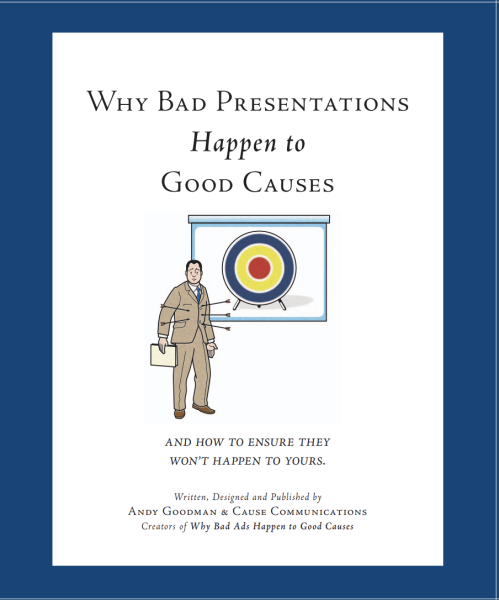In Case You Missed It: This month’s ICYMI was written by Andy Goodman in October 2005, revealing the questions to ask before delivering your next presentation.
A common mistake in planning a presentation is asking the seemingly innocent question,“What do I want to say?” Unfortunately, this places the initial focus on you and your material instead of where it actually belongs: on the audience. Start with this question, and you are off on a path of building a case (or telling a story, or solving a problem) that may seem compelling to you, but could very easily fall on deaf ears.
Joel Bradshaw, a political strategist who frequently works with environmental organizations (and one of several veteran presenters we interviewed for this book), has seen many clients make this mistake. “Most conservation organizations think that you persuade people by marshaling a series of scientific arguments and facts to change people’s minds,” says Bradshaw. “In reality, that isn’t what happens. You change people’s minds by figuring out what is important to them — which is rarely science—and you present arguments on their terms.”
 So before you can effectively engage, persuade, or educate the people in your audience, you have to find out what “their terms” are.
So before you can effectively engage, persuade, or educate the people in your audience, you have to find out what “their terms” are.
In some cases, audience research will require interviewing the conference organizer who scheduled your session. If you are working with a single organization, it may mean finding someone on the inside who can provide background on meeting attendees. Whatever the circumstances, there is almost always someone who will know more about the people in the room than you do. Find them, grill them, and take copious notes as they answer these questions:
Who will be in the audience, and how much do they know about the subject of my presentation?
One of the fastest ways to lose an audience is to begin talking above or below their level of knowledge or outside their job descriptions. Knowing job titles, having a general sense of the work they do, and learning as much as you can about their interest and understanding of your specific subject will help you pitch your talk at the appropriate level.
What do they know or believe that I can build on?
Rarely will you face an audience that is a blank slate. They are bound to have some feelings about your subject, and you want to fan whatever flickers of interest or support are out there. If you are proposing a plan for carpooling, for example, you may know going in that many people find it inconvenient and a hassle. But you are also likely to find that those same people detest sitting in traffic, and that will give you a better place to start a conversation.
What do they know or believe that I have to overcome?
Similarly, you don’t want to walk into an ambush. If the room is filled with people who aren’t sympathetic or even have reasons to oppose you, knowing this in advance will help you prepare arguments that speak directly to their concerns. When I talk to audiences about storytelling, for example, I often find that people are predisposed to think of stories as fun and entertaining, but certainly not a critical part of their communications toolkit. So I begin my presentations by naming that objection and helping audiences work past it. Only then can I move on to my goal, which is showing them how to use storytelling in their workplace.
By the end of my presentation, what do I want them to have learned?
In a typical one hour presentation, the audience will only remember a handful of points. So as you plan your talk, ask yourself: what three or four points would I want them to walk away with if they remembered nothing else?
By the end of my presentation, what do I want them to feel?
Human beings are emotional creatures by nature. If you present people with information without engaging their emotions in some way, they will walk away from your presentation saying,“that was interesting,” and then promptly return to their business and forget everything you just told them. If you want your audience to be angry, hopeful, fed up, curious, or inspired, you have to build towards that emotion, so know in advance how you want to send them off.
By the end of my presentation, what do I want them to do?
Don’t expect the audience to figure this part out for themselves. If you want them to consider your case, learn more, call their Senator, march in the street, or whatever, you have to explicitly build that “ask” into your presentation. Experienced speakers who give the same presentation many times regularly ask such questions in order to tailor the material to each new audience. Before conducting a presentation training for her clients, Christina Harbridge Law asks them to complete a five-page questionnaire. Peg Neuhauser, who delivers about 100 presentations in a year, will conduct up to 30 interviews with a single client organization.
“Tailoring is all,” says Jerry Weissman, author of Presenting to Win, and there is an additional value in constantly tweaking your material. “When I first started speaking,” says best-selling author Paul Hawken, “I got better and better at the same talk. But at a certain point, it is like breathing your own exhaust. As I continue to present, I give different talks every time. I do that for me, really, so I feel growth and challenge. The talks are not always as practiced, but they are more honest.”
To learn more ways to improve your presentations, register for our “Platinum Rules of Presenting” workshop on December 4 & 6.